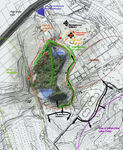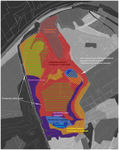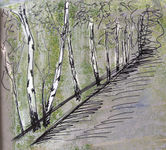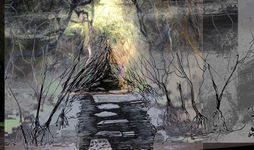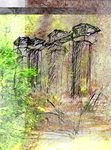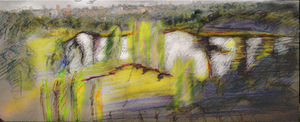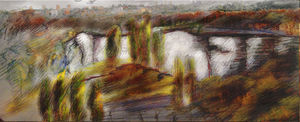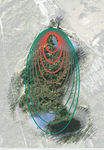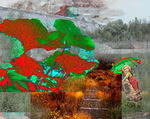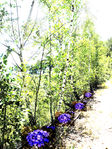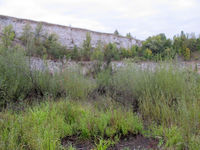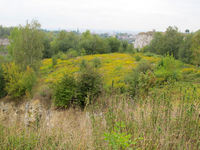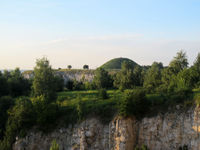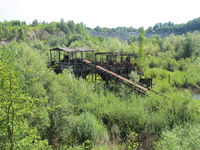Planting Design 2013 Working Group 27 - Case Study A
---> back to group page working group 27
Please add the title of your case study here, adjust the map coordinates and replace the moa image with a characteristic image of your site
| Name | Liban Quarry | |
| Location | Krakow | |
| Country | Poland | |
| Authors | Ilona Feklistova | |

| ||
|
| ||
Rationale: Why is this case interesting?
The area known as Liban quarry is an abandoned limestone extraction site. Placed only within 2,5 km from historical center of Krakow, the site became a sanctuary for wild life within last thirty years. The area does not have any official status and protection, but it has particular characteristics that attracts local people including me to come here for recreation.
- Why did you select it?
There are some relatively negative tendencies like eutrophication, spreading of invasive plants and overgrowing of valuable xerothermic plant communities. Thereby I want to make clear for myself as a landscape architecture if we should intervene in this kind of natural processes, even though it is an urban area, and if ‘yes’, where is the border between design and maintenance of the site and disturbing already established environment.
- Is it exemplary for a specific theme or a problem?
Overall, it is related to technogenic landscapes, restoration and new functions of similar sites.
- In how far does it relate to your life?
As you can see the site is placed in Poland,so it is not directly related to me and I had discovered it by accident during my research that was not related to that place. At the same time, it is possible to see many limestone quarries in Estonia with similar characteristics, some of them are abandoned, others will be out of use in the future, hence the issues can be relatively similar to Liban quarry.
Author's perspective
As a student of landscape architecture I want to understand what are the existing qualities of place, potentials and tendencies, and considering them to find better solution from ecological and social perspective
Landscape and/or urban context of your case
The Liban quarry is a result of dramatic changes in topography made by human during the last century and natural process of last thirty years. As result, the area has a range of particular characteristics and values from bio-geographical as well as cultural standpoint.
- Biogeography and dynamics
Topography is one of the most important characteristics of the site and contributes to the large diversity in biotopes. It is placed in Carpathian foredeep where base is formed by limestone plateau covered with glacial deposits. The experience of steep rocks reaching of 38 m changes with sun movement where the most dramatic can be seen the 'burning' rocks on South and contrasting shaded areas on North during the sunset.
The site is highly reach in biotopes; the area of Liban quarry serve as a refuge for water birds; upper meadows are highly diverse in plant species and provide habitat for many insects, birds and small mammals, woodlands bordering with quarry are mainly formed by broad-leaved species. Xerothermic grasslands characterize the site and are of great value.
The are also some negative tendencies, like erosion and landslides, spreading of invasive species, process of eutrophication in frequently flooded areas and overgrowing xerothermic grasslands with bushes.
- Cultural features
Due to topography the area was bypassed by any significant constructions. Used as industrial site during a century there can be still seen rusted constructions for limestone works. Even though they are not considered as valuable elements of cultural heritage, the contrast of form and color with green environment creates particular characteristics of the area. Also few of them form a landmark along with chimney of old industrial building placed at the entrance to the quarry.
The site was related to tragic events of II World War, where prisoners of Plaszow Labor Camp, placed within a half of kilometer, were working. In the northern part there can be seen a monument for 21 Poles, killed in quarry in 1944. In 1990s the Liban quarry became a 'scene' for filming 'Schindler's List' movie. There still can be found fake sets that became particular for the place (for ex. path with grave stones).
Next to the quarry, there is one of the oldest constructed elements in Krakow - the Krakus Mound. Being one of the highest points in the city it also contributes to the scale of the quarry, where difference between highest point of mound and lowest in quarry reaches 60m.
- Illustration:
- Map; sketches; short descriptive analyses
- highlight potentials and problems
Analytical drawings
- Natural dynamic versus cultural framework
The formal railroad tracks turn out to be a perfect 'bed' for birch trees. There may be several factors: first, as result of laying the tracks certain land works were done where limestone was replaced with loose materials; second, the rails had become a 'trap' for tree seeds; third, rails kept the leaves and other organic materials that led to formation humus between the lines. As result, the root system of trees and trails in complex decreasing erosion and protect from landslides. The birches also form high narrow path space that lead along the cliff.
It is important to notice that grave stones were placed as a decoration for Schindler's List movie and are real. After the film was done the scenery were abounded and in last twenty years, as result of competition for sunlight the willow bushes had densely enclosed the paths thereby creating green tunnel by vertical structure and providing contrasting walking experience. The bared roots of willow is the results of changes in water level when place become inaccessible.
- Dynamic through the year
In summer the area is very contrast where the domination of color refers to certain land cover; meadows stand out because of light green and yellow colors (result of dominative and invasive plant Solidago); the western upper part of the site is covered with dense broad-leaved forest and varies from light to dark green; the quarry is taken by hydrophilous plants like willows, poplar, common reed that give bluish color emphasized by shadow of northern cliff. Also strongly stand out rusted elements in contrast to green and blue.
- highlight potentials and problems
Projective drawings
- Please add four projective sketches/drawings (or montages/schemes) for your case and take the following aspects into account:
- How would you like this case to change in the near future? (in 1-2 years) will
- And how could it look like in 10-15 years?
- Projective Drawings
Concept plan. The area is dominated by pioneer species, that were able to colonize the damaged site. The biodiversity may be en-reached by presenting new species (compatible but not invasive) within the core area and provide moderate maintenance. Presumably, the new species will spread further contributing to biodiversity of the area.
Summary and conclusion
The frame created by human activity has contributed to establishment of new ecosystem in the urban environment, where ‘naturalness’ is the most valuable characteristic of the site – from ecological as well as aesthetic point of view. The area is in constant transformation where some processes can be seen as negative. Along with eutrophication and overgrown the area is limited within certain plant species (mainly pioneer plants) and the surrounding urban environment does not contribute to biodiversity. The main concept of my design proposal ‘Echo’ is to make accessible and to manage only core area near the passageway, and decrease human involvement in direction to the cliffs. The core area will be a place where the new species will be introduced (that can be compatible, but not dominate) assuming that naturally they will spread further and increase biodiversity in whole area. The maintenance should be done on a piecemeal basis, with only small areas managed in any one year to ensure continuity of habitat. Thus, the site can provide restorative environment for human as well as sanctuary for wildlife.
Image Gallery
- Image Gallery
References
* Please make sure that you give proper references of all external resources used.
* Do not use images of which you do not hold the copyright.
* Please add internet links to other resources if necessary.
About categories: You can add more categories with this tag: "", add your categories
